Mechanical Engineering Exam > Mechanical Engineering Questions > A spherical thermocouple junction of diameter...
Start Learning for Free
A spherical thermocouple junction of diameter 0.706 mm is to be used for the measurement of temperature of a gas stream. The convective heat transfer coefficient on bead surface is 400 W/m2K, Thermophysical properties of thermocouple material are k = 20 W/mK, c = 400 J/kgK and r = 8500 kg/m3. If the thermocouple initially at 30°C is placed in a hot stream of 300°C, the time taken by the bead to reach 298°C, is
[2004]
- a)2.35 s
- b)4.9 s
- c)14.7 s
- d)29.4 s
Correct answer is option 'B'. Can you explain this answer?
| FREE This question is part of | Download PDF Attempt this Test |
Verified Answer
A spherical thermocouple junction of diameter 0.706 mm is to be used f...
Given
h = 400 W/m2K, k = 20 W/mK c = 400 J/kg.K, ρ = 8500 kg/m3
h = 400 W/m2K, k = 20 W/mK c = 400 J/kg.K, ρ = 8500 kg/m3
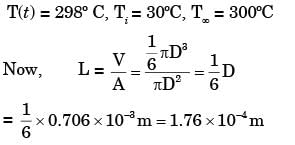
Biot Number = hL/k

Since Bi< 0.1, lumped system analysis can be used
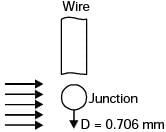
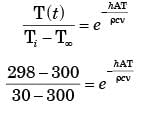
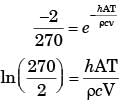
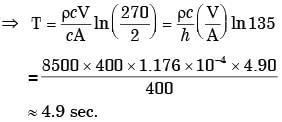
Most Upvoted Answer
A spherical thermocouple junction of diameter 0.706 mm is to be used f...
°C is exposed to the gas stream at 200 °C, we can calculate the rate of heat transfer from the gas to the thermocouple using the following formula:
q = h * A * ΔT
where:
q = rate of heat transfer (W)
h = convective heat transfer coefficient (W/m2K)
A = surface area of the thermocouple junction (m2)
ΔT = temperature difference between the gas and thermocouple (K)
First, let's calculate the surface area of the thermocouple junction:
r = diameter/2 = 0.706 mm / 2 = 0.353 mm = 0.353 * 10^-3 m
A = 4 * π * r^2 = 4 * 3.14159 * (0.353 * 10^-3)^2 = 1.56 * 10^-7 m2
Next, let's calculate the temperature difference:
ΔT = T_gas - T_thermocouple = 200 °C - 30 °C = 170 °C
Now we can calculate the rate of heat transfer:
q = 400 W/m2K * 1.56 * 10^-7 m2 * 170 K = 1.06 * 10^-3 W
Therefore, the rate of heat transfer from the gas to the thermocouple is approximately 1.06 milliwatts.
q = h * A * ΔT
where:
q = rate of heat transfer (W)
h = convective heat transfer coefficient (W/m2K)
A = surface area of the thermocouple junction (m2)
ΔT = temperature difference between the gas and thermocouple (K)
First, let's calculate the surface area of the thermocouple junction:
r = diameter/2 = 0.706 mm / 2 = 0.353 mm = 0.353 * 10^-3 m
A = 4 * π * r^2 = 4 * 3.14159 * (0.353 * 10^-3)^2 = 1.56 * 10^-7 m2
Next, let's calculate the temperature difference:
ΔT = T_gas - T_thermocouple = 200 °C - 30 °C = 170 °C
Now we can calculate the rate of heat transfer:
q = 400 W/m2K * 1.56 * 10^-7 m2 * 170 K = 1.06 * 10^-3 W
Therefore, the rate of heat transfer from the gas to the thermocouple is approximately 1.06 milliwatts.
Attention Mechanical Engineering Students!
To make sure you are not studying endlessly, EduRev has designed Mechanical Engineering study material, with Structured Courses, Videos, & Test Series. Plus get personalized analysis, doubt solving and improvement plans to achieve a great score in Mechanical Engineering.

|
Explore Courses for Mechanical Engineering exam
|

|
Similar Mechanical Engineering Doubts
A spherical thermocouple junction of diameter 0.706 mm is to be used for the measurement of temperature of a gas stream. The convective heat transfer coefficient on bead surface is 400 W/m2K, Thermophysical properties of thermocouple material are k = 20 W/mK, c = 400 J/kgK and r = 8500 kg/m3. If the thermocouple initially at 30°C is placed in a hot stream of 300°C, the time taken by the bead to reach 298°C, is[2004]a)2.35 sb)4.9 sc)14.7 sd)29.4 sCorrect answer is option 'B'. Can you explain this answer?
Question Description
A spherical thermocouple junction of diameter 0.706 mm is to be used for the measurement of temperature of a gas stream. The convective heat transfer coefficient on bead surface is 400 W/m2K, Thermophysical properties of thermocouple material are k = 20 W/mK, c = 400 J/kgK and r = 8500 kg/m3. If the thermocouple initially at 30°C is placed in a hot stream of 300°C, the time taken by the bead to reach 298°C, is[2004]a)2.35 sb)4.9 sc)14.7 sd)29.4 sCorrect answer is option 'B'. Can you explain this answer? for Mechanical Engineering 2024 is part of Mechanical Engineering preparation. The Question and answers have been prepared according to the Mechanical Engineering exam syllabus. Information about A spherical thermocouple junction of diameter 0.706 mm is to be used for the measurement of temperature of a gas stream. The convective heat transfer coefficient on bead surface is 400 W/m2K, Thermophysical properties of thermocouple material are k = 20 W/mK, c = 400 J/kgK and r = 8500 kg/m3. If the thermocouple initially at 30°C is placed in a hot stream of 300°C, the time taken by the bead to reach 298°C, is[2004]a)2.35 sb)4.9 sc)14.7 sd)29.4 sCorrect answer is option 'B'. Can you explain this answer? covers all topics & solutions for Mechanical Engineering 2024 Exam. Find important definitions, questions, meanings, examples, exercises and tests below for A spherical thermocouple junction of diameter 0.706 mm is to be used for the measurement of temperature of a gas stream. The convective heat transfer coefficient on bead surface is 400 W/m2K, Thermophysical properties of thermocouple material are k = 20 W/mK, c = 400 J/kgK and r = 8500 kg/m3. If the thermocouple initially at 30°C is placed in a hot stream of 300°C, the time taken by the bead to reach 298°C, is[2004]a)2.35 sb)4.9 sc)14.7 sd)29.4 sCorrect answer is option 'B'. Can you explain this answer?.
A spherical thermocouple junction of diameter 0.706 mm is to be used for the measurement of temperature of a gas stream. The convective heat transfer coefficient on bead surface is 400 W/m2K, Thermophysical properties of thermocouple material are k = 20 W/mK, c = 400 J/kgK and r = 8500 kg/m3. If the thermocouple initially at 30°C is placed in a hot stream of 300°C, the time taken by the bead to reach 298°C, is[2004]a)2.35 sb)4.9 sc)14.7 sd)29.4 sCorrect answer is option 'B'. Can you explain this answer? for Mechanical Engineering 2024 is part of Mechanical Engineering preparation. The Question and answers have been prepared according to the Mechanical Engineering exam syllabus. Information about A spherical thermocouple junction of diameter 0.706 mm is to be used for the measurement of temperature of a gas stream. The convective heat transfer coefficient on bead surface is 400 W/m2K, Thermophysical properties of thermocouple material are k = 20 W/mK, c = 400 J/kgK and r = 8500 kg/m3. If the thermocouple initially at 30°C is placed in a hot stream of 300°C, the time taken by the bead to reach 298°C, is[2004]a)2.35 sb)4.9 sc)14.7 sd)29.4 sCorrect answer is option 'B'. Can you explain this answer? covers all topics & solutions for Mechanical Engineering 2024 Exam. Find important definitions, questions, meanings, examples, exercises and tests below for A spherical thermocouple junction of diameter 0.706 mm is to be used for the measurement of temperature of a gas stream. The convective heat transfer coefficient on bead surface is 400 W/m2K, Thermophysical properties of thermocouple material are k = 20 W/mK, c = 400 J/kgK and r = 8500 kg/m3. If the thermocouple initially at 30°C is placed in a hot stream of 300°C, the time taken by the bead to reach 298°C, is[2004]a)2.35 sb)4.9 sc)14.7 sd)29.4 sCorrect answer is option 'B'. Can you explain this answer?.
Solutions for A spherical thermocouple junction of diameter 0.706 mm is to be used for the measurement of temperature of a gas stream. The convective heat transfer coefficient on bead surface is 400 W/m2K, Thermophysical properties of thermocouple material are k = 20 W/mK, c = 400 J/kgK and r = 8500 kg/m3. If the thermocouple initially at 30°C is placed in a hot stream of 300°C, the time taken by the bead to reach 298°C, is[2004]a)2.35 sb)4.9 sc)14.7 sd)29.4 sCorrect answer is option 'B'. Can you explain this answer? in English & in Hindi are available as part of our courses for Mechanical Engineering.
Download more important topics, notes, lectures and mock test series for Mechanical Engineering Exam by signing up for free.
Here you can find the meaning of A spherical thermocouple junction of diameter 0.706 mm is to be used for the measurement of temperature of a gas stream. The convective heat transfer coefficient on bead surface is 400 W/m2K, Thermophysical properties of thermocouple material are k = 20 W/mK, c = 400 J/kgK and r = 8500 kg/m3. If the thermocouple initially at 30°C is placed in a hot stream of 300°C, the time taken by the bead to reach 298°C, is[2004]a)2.35 sb)4.9 sc)14.7 sd)29.4 sCorrect answer is option 'B'. Can you explain this answer? defined & explained in the simplest way possible. Besides giving the explanation of
A spherical thermocouple junction of diameter 0.706 mm is to be used for the measurement of temperature of a gas stream. The convective heat transfer coefficient on bead surface is 400 W/m2K, Thermophysical properties of thermocouple material are k = 20 W/mK, c = 400 J/kgK and r = 8500 kg/m3. If the thermocouple initially at 30°C is placed in a hot stream of 300°C, the time taken by the bead to reach 298°C, is[2004]a)2.35 sb)4.9 sc)14.7 sd)29.4 sCorrect answer is option 'B'. Can you explain this answer?, a detailed solution for A spherical thermocouple junction of diameter 0.706 mm is to be used for the measurement of temperature of a gas stream. The convective heat transfer coefficient on bead surface is 400 W/m2K, Thermophysical properties of thermocouple material are k = 20 W/mK, c = 400 J/kgK and r = 8500 kg/m3. If the thermocouple initially at 30°C is placed in a hot stream of 300°C, the time taken by the bead to reach 298°C, is[2004]a)2.35 sb)4.9 sc)14.7 sd)29.4 sCorrect answer is option 'B'. Can you explain this answer? has been provided alongside types of A spherical thermocouple junction of diameter 0.706 mm is to be used for the measurement of temperature of a gas stream. The convective heat transfer coefficient on bead surface is 400 W/m2K, Thermophysical properties of thermocouple material are k = 20 W/mK, c = 400 J/kgK and r = 8500 kg/m3. If the thermocouple initially at 30°C is placed in a hot stream of 300°C, the time taken by the bead to reach 298°C, is[2004]a)2.35 sb)4.9 sc)14.7 sd)29.4 sCorrect answer is option 'B'. Can you explain this answer? theory, EduRev gives you an
ample number of questions to practice A spherical thermocouple junction of diameter 0.706 mm is to be used for the measurement of temperature of a gas stream. The convective heat transfer coefficient on bead surface is 400 W/m2K, Thermophysical properties of thermocouple material are k = 20 W/mK, c = 400 J/kgK and r = 8500 kg/m3. If the thermocouple initially at 30°C is placed in a hot stream of 300°C, the time taken by the bead to reach 298°C, is[2004]a)2.35 sb)4.9 sc)14.7 sd)29.4 sCorrect answer is option 'B'. Can you explain this answer? tests, examples and also practice Mechanical Engineering tests.

|
Explore Courses for Mechanical Engineering exam
|

|
Suggested Free Tests
Signup for Free!
Signup to see your scores go up within 7 days! Learn & Practice with 1000+ FREE Notes, Videos & Tests.
























